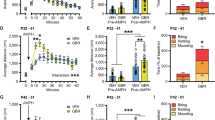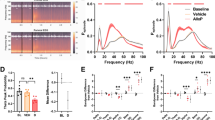Abstract
Low serotonin has been associated with aggressive behavior and impulsivity. Executive functions (cognitive abilities involved in the initiation/maintenance of goal attainment) have also been related to aggression. We tested whether dietary depletion of tryptophan, the amino acid precursor of serotonin, would increase disinhibition (impulsivity) in aggressive male adolescents. Cognitive-neuropsychological variables predictive of disinhibition were explored. Stable aggressive and nonaggressive adolescent men received balanced and tryptophan-depleted amino acid mixtures separately (counterbalanced, double-blind). Commission errors on a go/no-go learning task (i.e., failures to inhibit responding to stimuli associated with punishment/nonreward) measured disinhibition. Aggressive adolescent males made more commission errors as compared to nonaggressives. Lower executive functioning was significantly related to commission errors over and above conventional memory abilities. Tryptophan depletion had no effect on commission errors in the aggressive adolescents, possibly because of a ceiling effect.
Similar content being viewed by others
Log in or create a free account to read this content
Gain free access to this article, as well as selected content from this journal and more on nature.com
or
References
Becker JT, Butters N, Rivoira P, Miliotis P . (1986): Asking the right questions: Problem solving in male alcoholics and male alcoholics with Korsakoff's Syndrome. Alcohol Clin Exp Res 10: 641–646
Benkelfat C, Ellenbogen M, Dean P, Palmour R, Young SN . (1994): Mood-lowering effect of tryptophan depletion: Enhanced susceptibility in young men at genetic risk for major affective disorders. Arch Gen Psychiat 51: 687–697
Berman ME, Tracy JI, Coccaro EF . (1997): The serotonin hypothesis of aggression revisited. Clin Psychol Rev 17: 651–665
Blishen BR, Carroll WK, Moore C . (1987): The 1981 socioeconomic index for occupations in Canada. Can Rev Sociol Anthropol 24: 465–488
Brown GL, Ebert MH, Goyer PF, Jimerson DC, Klein WJ, Bunney WE, Goodwin FK . (1982): Aggression, suicide, and serotonin: Relationships to CSF amine metabolites. Am J Psychiat 139: 741–746
Cleare AJ, Bond AJ . (1995): The effect of tryptophan depletion and enhancement on subjective and behavioural aggression in normal male subjects. Psychopharmacology 118: 72–81
Coccaro EF, Kavoussi RJ . (1997): Fluoxetine and impulsive aggressive behavior in personality-disordered subjects. Arch Gen Psychiat 54: 1081–1088
Giancola PR, Zeichner A . (1994): Neuropsychological performance on tests of frontal-lobe functioning and aggressive behavior in men. J Abnorm Psychol 103: 832–835
Halperin JM, Sharma V, Siever LJ, Schwartz ST, Matier K, Wornell G, Newcorn JH . (1994): Serotonergic function in aggressive and nonaggressive boys with attention deficit hyperactivity disorder. Am J Psychiat 151: 243–248
Halperin JM, Newcorn JH, Schwartz ST, Sharma V, Siever LJ, Koda VH, Gabriel S . (1997): Age-related changes in the association between serotonergic function and aggression in boys with ADHD. Biol Psychiatry 41: 682–689
Iaboni F, Douglas VI, Baker AG . (1995): Effects of reward and response costs on inhibition in ADHD children. J Abnorm Psychol 104: 232–240
Kavoussi R, Armstead P, Coccaro EF . (1997): The neurobiology of impulsive aggression. Psychiat Clin North Am 20: 395–403
Kawashima R, Satoh K, Itoh H, Ono S, Furumoto S, Gotoh R, Koyama M, Yoshioka S, Takahashi T, Takahashi K, Yanagisawa T, Fukuda H . (1996): Functional anatomy of GO/NO-GO discrimination and response selection—A PET study in man. Brain Res 728: 79–89
Kruesi MJ, Rapoport JL, Hamburger S, Hibbs E, Potter WZ, Lenane M, Brown GL . (1990): Cerebrospinal fluid monoamine metabolites, aggression, and impulsivity in disruptive behavior disorders of children and adolescents. Arch Gen Psychiat 47: 419–426
Kruesi MJP, Hibbs ED, Zahn TP, Keysor CS, Hamburger SD, Bartko JJ, Rapoport JL . (1992): A 2-year prospective follow-up study of children and adolescents with disruptive behavior disorders. Arch Gen Psychiat 49: 429–435
Lau MA, Pihl RO, Peterson JB . (1995): Provocation, acute alcohol intoxication, cognitive performance, and aggression. J Abnorm Psychol 104: 150–155
LeMarquand DG, Pihl RO, Young SN, Tremblay RE, Palmour RM, Benkelfat C . (1997): Tryptophan depletion and behavioral disinhibition in men at risk for alcoholism and antisocial behavior. In Raine A, Brennan PA, Farrington DP, Mednick SA (eds), Biosocial Bases of Violence. New York, Plenum, pp 337–339
Lezak M . (1983): Neuropsychological Assessment New York, Wiley
Lezak MD . (1985): Neuropsychological assessment. In Frederiks JAM (ed), Handbook of clinical neurology: Vol. 1. Clinical neuropsychology. New York, Elsevier, pp 515–530
Linnoila M, Virkkunen M, Scheinin M, Nuutila A, Rimon R, Goodwin FK . (1983): Low cerebrospinal fluid 5-hydroxyindoleacetic acid concentration differentiates impulsive from nonimpulsive violent behavior. Life Sci 33: 2609–2614
Mâsse LC, Tremblay RE . (1997): Behavior of boys in kindergarten and the onset of substance use during adolescence. Arch Gen Psychiat 54: 62–68
Milner B, Petrides M, Smith ML . (1985): Frontal lobes and the temporal organization of memory. Human Neurobiol 4: 137–142
Moeller FG, Dougherty DM, Swann AC, Collins D, Davis CM, Cherek DR . (1996): Tryptophan depletion and aggressive responding in healthy males. Psychopharmacology 126: 97–103
Newman JP, Widom CS, Nathan S . (1985): Passive avoidance in syndromes of disinhibition: Psychopathy and extraversion. J Pers Soc Psychol 48: 1316–1327
Newman JP, Kosson DS . (1986): Passive avoidance learning in psychopathic and nonpsychopathic offenders. J Abnorm Psychol 95: 252–256
Newman JP, Patterson CM, Howland EW, Nichols SL . (1990): Passive avoidance in psychopaths: The effects of reward. Person Individ Diff 11: 1101–1114
Newman JP, Wallace JF . (1993): Diverse pathways to deficient self-regulation: Implications for disinhibitory psychopathology in children. Clin Psychol Rev 13: 699–720
Nishizawa S, Benkelfat C, Young SN, Leyton M, Mzengeza S, de Montigny C, Blier P, Diksic M . (1997): Differences between males and females in rates of serotonin synthesis in human brain. Proc Natl Acad Sci USA 94: 5308–5313
Patterson CM, Kosson DS, Newman JP . (1987): Reaction to punishment, reflectivity, and passive avoidance learning in extraverts. J Pers Soc Psychol 52: 565–575
Pennington BF, Ozonoff S . (1996): Executive functions and developmental psychopathology. J Child Psychol Psychiat 37: 51–87
Petrides M . (1990): Nonspatial conditional learning impaired in patients with unilateral frontal but not unilateral temporal lobe excisions. Neuropsychologia 28: 137–149
Petrides M, Alivisatos B, Evans AC, Meyer E . (1993a): Dissociation of human mid-dorsolateral from posterior dorsolateral frontal cortex in memory processing. Proc Natl Acad Sci USA 90: 873–877
Petrides M, Alivisatos B, Meyer E, Evans AC . (1993b): Functional activation of the human frontal cortex during the performance of verbal working memory tasks. Proc Natl Acad Sci USA 90: 878–882
Pihl RO, Young SN, Harden P, Plotnick S, Chamberlain B, Ervin FR . (1995): Acute effect of altered tryptophan levels and alcohol on aggression in normal human males. Psychopharmacology 119: 353–360
Pucilowski O, Kostowski J . (1980): Aggressive behavior and the central serotonergic system. Behav Brain Res 9: 33–48
Salomon RM, Mazure CM, Delgado PL, Mendia P, Charney DS . (1994): Serotonin function in aggression: The effects of acute plasma tryptophan depletion in aggressive patients. Biol Psychiatry 35: 570–572
Sattler JM . (1988): Assessment of Children. San Diego, CA JM Sattler (Publisher)
Séguin JR, Harden PW, Pihl RO, Tremblay RE, Boulerice B . (1995): Cognitive and neuropsychological characteristics of physically aggressive boys. J Abnorm Psychol 104: 614–624
Smith ML, Milner B . (1981): The role of right hippocampus in the recall of spatial location. Neuropsychologia 19: 781–793
Smith ML, Milner B . (1989): Right hippocampal impairment in the recall of spatial location: Encoding deficit or rapid forgetting? Neuropsychologia 27: 71–81
Smith SE, Pihl RO, Young SN, Ervin FR . (1987): Elevation and reduction of plasma tryptophan and their effects on aggression and perceptual sensitivity in normal males. Aggress Behav 12: 393–407
Soubrié P . (1986): Reconciling the role of central serotonin neurons in human and animal behavior. Behav Brain Sci 9: 319–364
Tabachnick BG, Fidell LS . (1989): Using Multivariate Statistics New York, NY, HarperColins
Tremblay RE, Loeber R, Gagnon C, Charlebois P, Larivée S, LeBlanc M . (1991): Disruptive boys with stable and unstable high fighting behavior patterns during junior elementary school. J Abnorm Child Psychol 19: 285–300
Tuinier S, Verhoeven WMA, van Praag HM . (1995): Cerebrospinal fluid 5-hydroxyindoleacetic acid and aggression: A critical reappraisal of the clinical data. Int Clin Psychopharmacol 10: 147–156
Virkkunen M, Rawlings R, Tokola R, Poland RE, Guidotti A, Nemeroff C, Bissette G, Kalogeras K, Karonen S-L, Linnoila M . (1994): CSF biochemistries, glucose metabolism, and diurnal activity rhythms in alcoholic, violent offenders, fire setters, and healthy volunteers. Arch Gen Psychiat 51: 20–27
Wechsler D . (1974): Manual for the Wechsler Intelligence Scale for Children—Revised New York, Psychological Corporation
Wechsler D . (1987): Wechsler Memory Scale—Revised New York, Psychological Corporation
Wiegersma S, van der Scheer E, Hijman R . (1990): Subjective ordering, short-term memory, and the frontal lobes. Neuropsychologia 28: 95–98
Wilkins K . (1990): Eosinophilia-myalgia syndrome. Can Med Ass J 142: 1265–1266
Acknowledgements
We thank Molly Fortin, Fabienne Gauthier, and Claudine Morin for assistance with blood draws; Carole Blanchet, Dorothy Opatowski, Isabelle Tremblay, Jolène Gauthier, Richard Legros, and Jennifer Weiner for assistance in testing; Mark Gross and Franceen Lenoff for technical assistance; and Judi Young and Liz Rusnak for secretarial assistance. This research was conducted by David LeMarquand in partial fulfillment of the requirements for the Ph.D. degree from the Department of Psychology, McGill University. This work was supported by grants from the Medical Research Council of Canada, Ottawa, Ontario (Drs. Pihl, Young, and Benkelfat), and doctoral and dissertation fellowships to D. LeMarquand from the Fonds pour la Formation de Chercheurs et L'Aide à la Recherche (FCAR), and the Guggenheim Foundation, New York. Portions of this research were presented at the Society for Biological Psychiatry, New York, May 1996; the Canadian College of Neuropsychopharmacology, Toronto, Canada, June 1996; and the NATO Advanced Study Institute on the Biosocial Bases of Violence: Theory and Research, Rhodes, Greece, May 1996.
Author information
Authors and Affiliations
Rights and permissions
About this article
Cite this article
LeMarquand, D., Pihl, R., Young, S. et al. Tryptophan Depletion, Executive Functions, and Disinhibition in Aggressive, Adolescent Males. Neuropsychopharmacol 19, 333–341 (1998). https://doi.org/10.1016/S0893-133X(98)00029-3
Received:
Revised:
Accepted:
Issue date:
DOI: https://doi.org/10.1016/S0893-133X(98)00029-3



